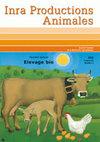Gérer les variations des apports alimentaires des vaches laitières au pâturage
IF 0.6
4区 农林科学
Q3 Agricultural and Biological Sciences
引用次数: 0
Abstract
Grazed pasture is the cheapest source of nutrients for dairy cows and should form the basis of profitable and low input animal production systems. Management of high producing dairy cows at pasture is thus a major challenge in most countries. The objective of the present paper is to review the factors affecting nutrient supply for grazing dairy cows in order to point out areas with scope for improvement on managing variations in nutrient supply to achieve high animal performance while maintaining efficient pasture utilisation per hectare. Reviewing the range in animal nutrient requirements, intake capacity and pasture nutritive values shows that high producing cows cannot satisfy their energy requirements from grazing alone. Favourable to unfavourable situations for grazing dairy cows may be defined according to pasture quality and availability. Predictive models also enable to calculate supplementation level required to meet energy requirements in various situations. Solutions to maintain acceptable level of production per cow and high output per ha are discussed. Strategies of concentrate supplementation and increasing use of legumes in mixed swards are the most promising. It is concluded that there is scope for improving animal performance at grazing given recent developments in our understanding of factors influencing pasture intake and digestion.管理牧场奶牛饲料摄入量的变化
放牧的牧场是奶牛最便宜的营养来源,应成为盈利和低投入的动物生产系统的基础。因此,在大多数国家,管理牧场上的高产奶牛是一项重大挑战。本文的目的是回顾影响放牧奶牛营养供应的因素,以指出在管理营养供应变化方面有改进余地的领域,以实现高动物生产性能,同时保持每公顷牧草的有效利用。回顾动物营养需要量、采食量和牧草营养价值的范围,高产奶牛不能仅靠放牧来满足其能量需求。奶牛放牧的有利和不利条件可根据牧草的质量和可用性来确定。预测模型还可以计算在各种情况下满足能量需求所需的补充水平。讨论了维持每头奶牛可接受的产量水平和每公顷高产量的解决方案。在混合草地中补充精料和增加豆科植物的利用是最有希望的策略。综上所述,鉴于我们对影响牧草采食和消化的因素的理解的最新进展,放牧动物的生产性能仍有提高的余地。
本文章由计算机程序翻译,如有差异,请以英文原文为准。
求助全文
约1分钟内获得全文
求助全文
来源期刊

Inra Productions Animales
Multiple-
CiteScore
1.30
自引率
33.30%
发文量
0
审稿时长
>36 weeks
期刊介绍:
This journal publishes scientific update reports, results of experiments and their possible applications, analyses on topical issues and presentation of research, information on scientific events and new publications.
INRA Productions Animales deals with all species of zootechnical interest (herbivores, monogastrics and fish), covering feed and nutrition, physiology, pathology, genetics, production techniques, product quality and production economics.
 求助内容:
求助内容: 应助结果提醒方式:
应助结果提醒方式:


